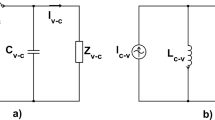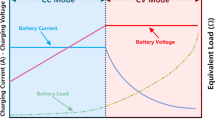Abstract
It is well known that when applying wireless power transfer technology to energy storage loads, higher-order compensation networks can implement the load-independent output characteristics and simplify the control system. Analysis methods based on the equivalent model can effectively reduce the design complexity of high-order compensation networks. However, additional analysis is required to maintain zero phase angle of input voltage and input current and implement soft switching during the entire charge process simultaneously, when these analysis methods are adopted. Therefore, a composite network model, which is able to systematically analyze the load-independent output characteristics, zero phase angle, and soft-switching conditions of the higher-order compensation network, is proposed in this paper. To verify the reliability and effectiveness of the proposed composite network model, a 100-W lab prototype charger with the double-sided LCC compensation circuit has been built. Moreover, the composite model can be applied to other higher-order networks.














Similar content being viewed by others
References
Xie K, Xu J, Pan Z (2020) Research and application of anti-offset wireless charging plant protection UAV. Electr Eng 102:2529–2537. https://doi.org/10.1007/s00202-020-01049-9
Darvish P, Mekhilef S, Illias HAB (2021) A novel S-S–LCLCC compensation for three-coil WPT to improve misalignment and energy efficiency stiffness of wireless charging system. IEEE Trans Power Electro 36(2):1341–1355. https://doi.org/10.1109/TPEL.2020.3007832
Qing X, Su Y, Hu AP et al (2021) A CPT system with switchable compensation for constant current or voltage output against load and coupling capacitance variations. Electr Eng 103:2391–2402. https://doi.org/10.1007/s00202-021-01235-3
Aydin E, Yildiriz E, Aydemir MT (2021) A new semi-analytical approach for self and mutual inductance calculation of hexagonal spiral coil used in wireless power transfer systems. Electr Eng 103:1769–1778. https://doi.org/10.1007/s00202-020-01194-1
Gao T, Wang X, Jiang L et al (2021) Research on power distribution in multiple-input multiple-output magnetic coupling resonance wireless power transfer system. Electr Eng 103:3217–3224. https://doi.org/10.1007/s00202-021-01302-9
Gati E, Kampitsis G, Manias S (2017) Variable frequency controller for inductive power transfer in dynamic conditions. IEEE Trans Power Electron 32(2):1684–1696. https://doi.org/10.1109/TPEL.2016.2555963
Li Y, Hu J, Chen F, Li Z, He Z, Mai R (2018) Dual-phase-shift control scheme with current-stress and efficiency optimization for wireless power transfer systems. IEEE Trans Circuits-I 65(9):3110–3121. https://doi.org/10.1109/TCSI.2018.2817254
Jou H-L, Wu J-C, Wu K-D, Kuo C-Y (2021) Bidirectional DC–DC wireless power transfer based on LCC-C resonant compensation. IEEE Trans Power Electr 36(2):2310–2319. https://doi.org/10.1109/TPEL.2020.3005804
Chen Y et al (2020) Variable-parameter T-circuit-based IPT system charging battery with constant current or constant voltage output. IEEE Trans Power Electr 35(2):1672–1684. https://doi.org/10.1109/TPEL.2019.2920948
Song K, Li Z, Jiang J, Zhu C (2018) Constant current/voltage charging operation for series-series and series-parallel compensated wireless power transfer systems employing primary-side controller. IEEE Trans Power Electr 33(9):8065–8080. https://doi.org/10.1109/TPEL.2017.2767099
Li Y et al (2019) Reconfigurable intermediate resonant circuit based WPT system with load-independent constant output current and voltage for charging battery. IEEE Trans Power Electr 34(3):1988–1992. https://doi.org/10.1109/TPEL.2018.2858566
Yan Z et al (2022) A monitoring equipment charging system for HVTL based on domino-resonator WPT with constant current or constant voltage output. IEEE Trans Power Electr 37(3):3668–3680. https://doi.org/10.1109/TPEL.2021.3123506
Li J, Zhang X, Tong X (2022) A multi-objective-based parametric design method for WPT systems with double-sided LCC compensation network. Electr Eng. https://doi.org/10.1007/s00202-021-01479-z
Zhang W, Mi CC (2016) Compensation topologies of high-power wireless power transfer systems. IEEE Trans Veh Technol 65(6):4768–4778. https://doi.org/10.1109/TVT.2015.2454292
Lu J, Zhu G, Lin D, Wong S, Jiang J (2019) Load-independent voltage and current transfer characteristics of high-order resonant network in IPT system. IEEE J Emerg Sel Topics Power Electron 7(1):422–436. https://doi.org/10.1109/JESTPE.2018.2823782
Vu V, Tran D, Choi W (2018) Implementation of the constant current and constant voltage charge of inductive power transfer systems with the double-sided LCC compensation topology for electric vehicle battery charge applications. IEEE Trans Power Electron 33(9):7398–7410. https://doi.org/10.1109/TPEL.2017.2766605
Qu X, Chu H, Wong S, Tse CK (2019) An IPT battery charger with near unity power factor and load-independent constant output combating design constraints of input voltage and transformer parameters. IEEE Trans Power Electron 34(8):7719–7727. https://doi.org/10.1109/TPEL.2018.2881207
Li S, Li W, Deng J, Nguyen TD (2015) A double-sided LCC compensation network and its tuning method for wireless power transfer. IEEE Trans Veh Technol 64(6):2261–2273
Wang Y, Yao Y, Liu X, Xu D (2017) S/CLC compensation topology analysis and circular coil design for wireless power. Transf IEEE Trans Transp Electr 3(2):496–507. https://doi.org/10.1109/TTE.2017.2651067
Yang L, Li X, Liu S, Xu Z, Cai C (2021) Analysis and design of an LCCC/S-compensated WPT system with constant output characteristics for battery charging applications. IEEE J Emerg Sel Topics Power Electron 9(1):1169–1180
Feng H, Cai T, Duan S, Zhao J, Zhang X, Chen C (2016) An LCC-compensated resonant converter optimized for robust reaction to large coupling variation in dynamic wireless power transfer. IEEE Trans Ind Electron 63(10):6591–6601. https://doi.org/10.1109/TIE.2016.2589922
Qu X et al (2019) Design range of constant output current using double-sided LC compensation circuits for inductive-power-transfer applications. IEEE Trans Power Electron 34(3):2364–2374. https://doi.org/10.1109/TPEL.2018.2839769
Author information
Authors and Affiliations
Corresponding author
Additional information
Publisher's Note
Springer Nature remains neutral with regard to jurisdictional claims in published maps and institutional affiliations.
Rights and permissions
Springer Nature or its licensor holds exclusive rights to this article under a publishing agreement with the author(s) or other rightsholder(s); author self-archiving of the accepted manuscript version of this article is solely governed by the terms of such publishing agreement and applicable law.
About this article
Cite this article
Li, J., Zhang, X. & Tong, X. A composite network model for load-independent output and near unit power factor in WPT system. Electr Eng 104, 4571–4579 (2022). https://doi.org/10.1007/s00202-022-01640-2
Received:
Accepted:
Published:
Issue Date:
DOI: https://doi.org/10.1007/s00202-022-01640-2




